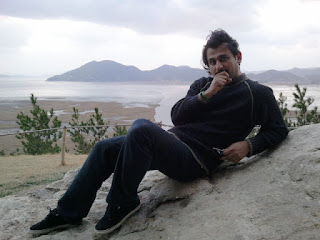Suncheon Bay
is described as the best wetland area in Korea. Suncheon Bay, home to Korea's
best foreshore, is called the reed kingdom of Korea. The sunset at Suncheon is
very famous and people from far away just come to see the sun set at this spot.
Last time I was unable to see the sunset
coz of raining. So I was excited this time. And I was lucky enough that I catch
the sunset for just few minutes, as it was cloudy… J Thanks to K Shuttle who helped me to come my dream true.
The local
government has made many observatories from where one can easily see the
beautiful view of bay. Unfortunately it was cloudy weather with a little rain
but it was still very cool to visit such a lovely place, the track of Suncheon
bay was really nice where the track is covered by beautiful small and medium
sized rice trees.
Suncheon bay is the habitat of mud skipper like crabs, hooded crane, and various kinds of migrated birds. …. The look of Suncheon bay from young saw observation platform is awesome, especially we were told that the sunset of Suncheon bay is attractive and people use it for postcards. Suncheon bay is considered as one of the most beautiful and biologically diverse area in Korea. It is also one of the only 5 completely protected wetland in the world. For me it was like a dream place. Although we had a short stay over there but I still feel the beauty and charm of that place. Through the co-existence of the nature's richness and people's eco-friendly environment, it will remind us of all the preciousness of the nature.
After arrival to Suncheon Bay, the first thing you can visit is the Natural Ecology Museum. It is a good place to learn all about the various living creatures that live in Suncheon Bay. Using the Eco info desk in the center hall on the first floor and the CCTV that shows the whole Suncheon Bay area will be helpful. Visiting this place before going into the actual path with reeds will make the experience twice as fun and meaningful.
Looking at the wooden tunnel that opens the gate to the path of reeds, the sight of the huge loofahs and the pumpkins hanging high in the sky make us feel the virtuousness of the nature. If you see the semicircle looking bridge not far from the gate, the path of reeds of 5.4km, the longest one in Korea really begins.
Especially during the Winter, the Hooded cranes (the 228th natural monument) also known as the 'living fossil' come to Suncheon Bay and paint the place with their feathers. It is easy to find the birds catching the preys with long beaks on the mud flat and the birds resting on the boats embarked on the bay. It is fun to watch the luespotted mud hoppers, the sand crabs, the philyra pisums, and the macrophthalmus japonicus on the mud flat of each side of the thick reeds.
You can see some adults who catch the crabs to show their children, but it is strongly prohibited in order to protect the ecology. At the end of the path of reeds, there is YongSanJoo Observatory where we can see the whole Suncheon Bay with 5.4km of reeds on the north side and the 22.6km of vast mud flat on the south.
If you're traveling with your family or not comfortable enough to walk, you can always take the Train of Reeds and appreciate the rich, beautiful sight of Suncheon Bay. The Train of Reeds provides 40 minutes of tour service from the rest area to the Nante Garden passing the Fresh Water Managing Center Taking the boat is another option to appreciate the magnificent view of Suncheon Bay mingled with the reeds and to explore the beauty of suncheon bay. But above all the walk through the reeds to reach the observatory..
We have been told through a video that Suncheon bay will host the International Garden Expo in 2013 that would feature gardens and horticulture products from around the world.The 29-member International Organization of Horticulture Producers unanimously voted for Suncheon, 415 km southwest of Seoul, as the venue for the expo in an assembly meeting held in Spain, officials said.
The exhibition will be held for six months from April to October in 2013 in Suncheon and its adjacent bay area, where a space of 152 hectares is set for developing green space.
| Closed | ||||||
| Mondays (When a national holiday falls on Monday, the next day is treated as a holiday) | ||||||
| Operating Hours | ||||||
| Park: 09:00- 1 hour after sunset Astronomical Observatory: 09:00-22:00 (ticket office closes at 21:00)
|























No comments:
Post a Comment